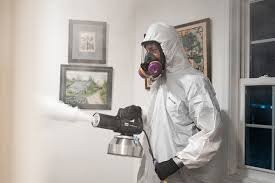Decomposition odor is one of the most challenging and distressing issues a property owner or occupant can face. Whether due to unattended deaths, animal carcasses, or severe biohazard situations, the smell of decomposition is not only unpleasant but also a serious health concern. This is where professional decomposition odor removal services come into play, providing expert solutions to restore both safety and comfort in affected spaces.
Understanding Decomposition Odor
Decomposition odor is caused by the natural breakdown of organic matter. As tissues decompose, they release volatile organic compounds (VOCs) such as cadaverine and putrescine, which produce the distinctive foul smell. These compounds can penetrate walls, carpets, furniture, and other porous surfaces, making the odor extremely difficult to remove without professional intervention.
Notably, decomposition odors are not just unpleasant; they can pose health risks. The bacteria involved in decomposition can lead to respiratory issues, allergic reactions, and the spread of disease. Therefore, proper cleaning and deodorization are critical for the safety of anyone entering the affected area.
Why Professional Decomposition Odor Removal is Essential
Many property owners underestimate the complexity of removing decomposition odors. While household cleaning products may temporarily mask the smell, they cannot fully neutralize the odor or sanitize the environment. Professional services employ specialized techniques that ensure both odor elimination and biohazard safety.
Key reasons to hire experts include:
- Advanced Decontamination Techniques – Professionals use industrial-grade cleaning agents, ozone generators, and thermal fogging to penetrate deep into affected materials, neutralizing odor-causing molecules.
- Biohazard Safety – Handling decomposed matter involves exposure to harmful bacteria and pathogens. Technicians follow strict OSHA and CDC guidelines to prevent contamination and ensure personal safety.
- Structural Restoration – Decomposition odors often permeate walls, flooring, and HVAC systems. Experts can treat these areas effectively, sometimes requiring the removal of contaminated materials, to prevent lingering odors.
- Peace of Mind – Knowing that a trained team is managing the cleanup alleviates emotional stress, especially in cases involving unattended deaths or traumatic situations.
The Decomposition Odor Removal Process
Professional decomposition odor removal follows a systematic approach to ensure complete sanitation and odor neutralization. While the exact process may vary based on the situation, the general steps include:
1. Assessment and Inspection
The first step involves a thorough assessment of the affected area. Technicians identify the source of the odor, evaluate the extent of contamination, and determine the best treatment methods. This stage is crucial for tailoring a plan that addresses both odor elimination and biohazard removal.
2. Containment and Safety Measures
Once the area is assessed, technicians establish containment protocols to prevent cross-contamination. This often includes sealing off the affected space, using protective gear, and setting up air filtration systems to minimize the spread of pathogens and odor particles.
3. Removal of Contaminated Materials
Porous materials such as carpets, upholstery, and drywall that have absorbed decomposition odors may need to be removed and properly disposed of as biohazard waste. In some cases, salvageable items can be treated with specialized cleaning solutions to eliminate odor while preserving property.
4. Deep Cleaning and Disinfection
The remaining surfaces are thoroughly cleaned using industrial-strength disinfectants and enzymatic cleaners. Enzymatic treatments are particularly effective, as they break down organic compounds at the molecular level, neutralizing the odor at its source rather than masking it.
5. Odor Neutralization
After cleaning, odor-neutralizing techniques such as ozone treatment, hydroxyl generators, or thermal fogging are employed. These methods penetrate deep into walls, floors, and HVAC systems to remove any remaining VOCs, ensuring that the space is odor-free.
6. Final Inspection and Clearance
The final stage involves a detailed inspection to confirm that the odor has been eliminated and the area is safe for occupancy. Technicians may use specialized instruments to detect any remaining contaminants and provide certification of cleanup if required for legal or insurance purposes.
Choosing the Right Decomposition Odor Removal Service
When selecting a professional service, consider the following factors:
- Experience and Certification – Look for companies with experience in biohazard cleanup and proper certifications, such as IICRC (Institute of Inspection, Cleaning and Restoration Certification) and OSHA compliance.
- 24/7 Availability – Decomposition incidents often occur unexpectedly. Companies offering round-the-clock services can respond promptly, minimizing odor spread and contamination.
- Transparent Pricing – Reputable services provide clear estimates upfront, including labor, materials, and disposal fees, avoiding hidden costs.
- Reputation and Reviews – Check client reviews and testimonials to ensure the service has a proven track record of effective odor removal and customer satisfaction.
Beyond Odor Removal: Comprehensive Biohazard Cleanup
Decomposition odor removal is often part of a broader biohazard cleanup service. Professionals can also handle bloodborne pathogens, trauma scenes, and other hazardous materials, ensuring that the entire property is sanitized and safe for use. Comprehensive services not only eliminate odors but also reduce health risks, restore property, and provide peace of mind.
Preventive Measures and Maintenance
While decomposition incidents are often unforeseeable, certain preventive steps can help minimize the impact:
- Prompt Reporting – Addressing unattended deaths or animal carcasses quickly reduces the severity of odor and contamination.
- Regular Property Inspections – Routine checks can help identify potential issues, such as dead animals in attics or crawl spaces, before they become major problems.
- Professional Maintenance – Regular HVAC cleaning and ventilation maintenance can reduce odor buildup and improve air quality.
Conclusion
Decomposition odors are more than just unpleasant—they are a serious biohazard that requires professional intervention. Decomposition odor removal services provide expert cleaning, disinfection, and odor neutralization, restoring safety and comfort to affected spaces. By employing advanced techniques and adhering to strict safety protocols, these services ensure complete elimination of odors while protecting both property and occupants.
Whether dealing with a traumatic event, animal decomposition, or other biohazard scenarios, hiring a professional service is the most effective way to manage the situation. Comprehensive, reliable, and efficient, decomposition odor removal specialists are the key to reclaiming a clean, safe, and odor-free environment.


